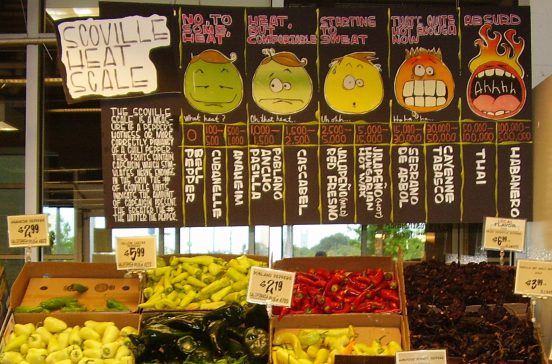One of the things that made me get deeper into “chilli cuisine” is that there is something special to it.
Not in the heat, but in its profile – which is usually overlooked, badly.
The Misunderstanding of Pungency
Many people only get into chilli far enough to know if they like it hot or not, and how hot. Many become chile pepper fiends are all about the pungency. Witness the ever-new records in Scoville Heat Units produced by superhot breeds.
The special something of the chilli, however, is that it is decidedly *not* all about the heat. (As I already pointed out in another article starting a series on misconceptions about the chilli…)
The level of pungency of a pepper, derived from measurements of capsaicin content, translated into Scoville Heat Units or put into the popular 10-level pungency scale, is not the main concern.
The Proper Pepper
The level of pungency only plays part of a role. What makes a chile pepper right for a dish, what makes it give the dish its proper characteristics, is also how quickly the heat comes on, where it burns the most, how long it lingers or quickly it dissipates.
I learnt that from Hunan cooking – and I was not the only one to notice, apparently.
How Is the Heat?
For a spice that has been so important for thousands of years where it originated, then quickly became essential to many a cuisine around the world, and has been so for hundreds of years, little thought was given to these characteristics.
Ivette Guzmán and Paul W. Bosland have, finally, produced a set of descriptors for the “sensory properties of chile pepper heat” in a paper published in the journal Appetite in 2017.
As they point out, “Asian cuisine first shed light on the importance of chile pepper heat profiles,” referencing Ku, Lee, & Park 2012; and it is not just total capsaicin(oids), but the relative content of different capsaicinoids which determine how a pepper variety tastes and whether this profile fits a certain cuisine.
(I am more than a little happy to read that, as it was one of my long-standing hypotheses. There just hadn’t been any confirmation I knew of, so far.)
For example, they point out how rocoto, Capsicum pubescens (the very pepper that had me thinking different capsaicinoids may play that role), often has less capsaicin(oid) content than other peppers, but tastes hotter. No wonder when it has “a heat profile that is rapid, incredibly sharp, with a whole mouth effect including lips, mid-palate, and throat”… and “it is one of the most lingering heats of all the chile peppers”!
Here, we already find some of their descriptors, which are:
- Development – very rapid, rapid, moderately rapid or delayed
- Feeling – sharp-prickling or flat (or incredibly sharp, e.g. for the rocoto)
- Location – lips, tip of tongue, front of mouth, side of tongue, mid-palate, throat, back of throat
- Intensity – extremely hot, very hot, hot, medium hot, mild
- Duration – dissipates quickly, dissipates, lingers (with location)
This is a fantastic set of descriptors because it really gives the toolkit necessary to describe what had often gone missing when people were asking, at most, about the pungency (here: intensity).
With habaneros (Capsicum chinense), it at least worked to point out that the intensity is not always extreme and there are also special flavors.
With many chiles, however, there was something more to them that was essential for cooking but that we did not have the (unified) vocabulary to describe. Until now.
[Header image: PepperswithscovilleCentralMarketHoustonTX.JPG, published to Wikimedia Commons under Public Domain, https://commons.wikimedia.org/wiki/File:PepperswithscovilleCentralMarketHoustonTX.JPG]


Leave a Reply
You must be logged in to post a comment.